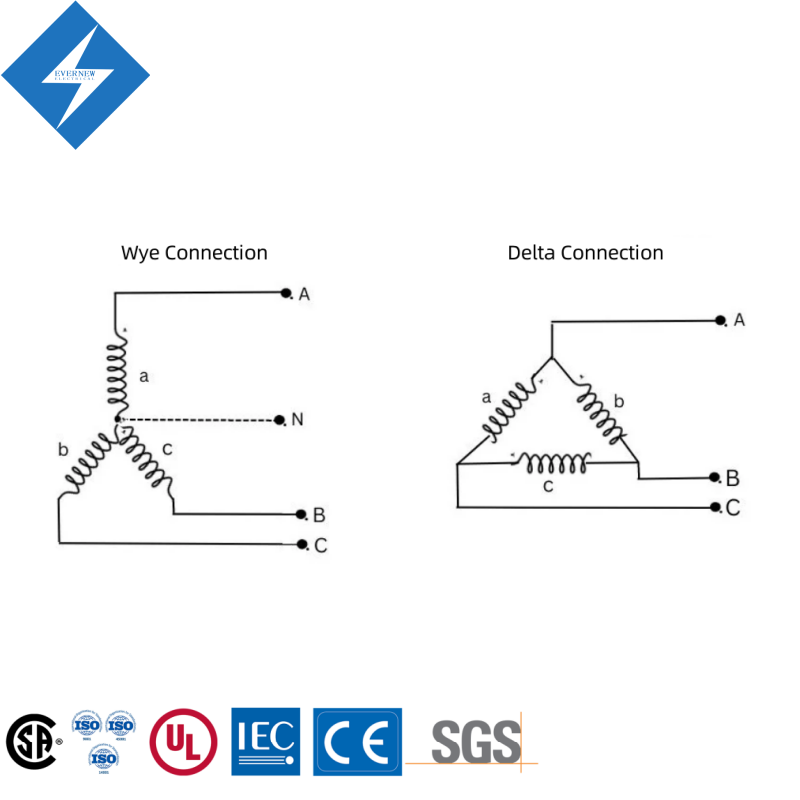Transformers are crucial components in power systems, and their winding connections directly affect their performance and application scenarios. The common transformer winding connections are the delta connection (D) and the star connection (Y or Yn). This article will provide a detailed overview of these two connection types, their notation methods, connection groups, and the advantages and applications of each.
I. Notation Method for Transformer Connection Groups
1. Meaning of Uppercase and Lowercase Letters
The connection group of a transformer is denoted by uppercase and lowercase letters: uppercase letters indicate the primary side (or high-voltage side) connection type, and lowercase letters indicate the secondary side (or low-voltage side) connection type. Specifically:
- Y (or y): Star connection
- D (or d): Delta connection
The numbers use the clock notation to represent the phase relationship between the primary and secondary line voltages, where the primary line voltage phasor is the minute hand fixed at the 12 o’clock position, and the secondary line voltage phasor is the hour hand.
2. Example of a Typical Group
For instance, “Yn, d11” indicates a primary side star connection with a neutral line, a secondary side delta connection, and a secondary line voltage lagging the primary line voltage by 330 degrees (or leading by 30 degrees). In this notation, 11 means that when the primary line voltage phasor is at the 12 o’clock position, the secondary line voltage phasor is at the 11 o’clock position.
Learn more about: Delta Wye Transformer
II. Common Transformer Connection Groups
The combination of two windings in a transformer forms the following four connection groups:
- Y, y
- D, y
- Y, d
- D, d
The commonly used connection groups are “Y, y” and “Y, d”.
Yyn0 Connection Group
- High-voltage side: Star connection (Y) with neutral grounding
- Low-voltage side: Star connection (y) with neutral grounding
- Primary and secondary line voltage phasors overlap, indicated by “0” on the clock.
Dyn11 Connection Group
- High-voltage side: Delta connection (D)
- Low-voltage side: Star connection (y) with a neutral line
- Primary and secondary line voltage phasors differ by 330 degrees (11 o’clock on the clock).
III. Performance Analysis of Connection Groups
1. No-load Loss
- Yyn0 Connection Group: The high-voltage side star connection generates a sinusoidal excitation current, but due to the nonlinearity of the magnetization curve, the core flux contains significant third harmonic components, increasing hysteresis and eddy current losses.
- Dyn11 Connection Group: The third harmonic current can circulate within the high-voltage winding, making the core flux sinusoidal and reducing losses. The no-load loss of Dyn11 connections can be about 10% less than that of Yyn0 connections.
2. Zero-sequence Current
- Yyn0 Connection Group: Unbalanced secondary load generates zero-sequence flux, increasing additional losses. Large-capacity transformers are not suitable for this connection method.
- Dyn11 Connection Group: Zero-sequence current in the primary winding can circulate within the winding, weakening the secondary winding’s zero-sequence flux and reducing overheating. The load loss of Dyn11 connections can be about 20% less than that of Yyn0 connections.
3. Single-phase Short Circuit
- Dyn11 Connection Group: Low zero-sequence impedance, resulting in high single-phase short-circuit current on the low-voltage side and high protection sensitivity.
- Yyn0 Connection Group: High zero-sequence impedance, resulting in high zero-sequence voltage and significant asymmetry in phase voltage.
IV. Selection of Connection Methods in Practice
1. Delta Connection on the Low Voltage Side of the Main Transformer
- Reason: Eliminates third harmonics and prevents harmonic distortion in the power grid voltage waveform. Zero-sequence current forms a circulating current in the delta connection, maintaining power quality.
2. Principles for Choosing Connection Methods
- Y-D Connection: Typically used for step-down transformers, as the high-voltage side star connection reduces line losses.
- D-Y Connection: Typically used for step-up transformers, but also common in distribution transformers where the low-voltage side is grounded.
3. Handling Special Cases
- Y-Y Connection: Generally not used due to the lack of harmonic paths, which can cause significant output distortion.
- Multi-stage Transformer Issues: For example, a 10/0.4kV transformer supplying power to an office building needs to ensure the neutral line is grounded when transforming 400V or 380V to 110V for specific equipment.
V. Conclusion
Choosing the appropriate transformer connection method is crucial for the safe and stable operation of power systems. Proper connection methods can reduce losses, improve efficiency, suppress harmonics, and ensure power quality. In practical applications, the appropriate connection method should be selected based on specific needs, leveraging each method’s advantages to ensure the reliability and economic efficiency of the power system.

